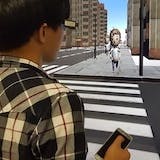@inproceedings{Roy2019_eyewear_pointing,
abstract = {Eyewear displays allow users to interact with virtual content displayed over real-world vision, in active situations like standing and walking. Pointing techniques for eyewear displays have been proposed, but their social acceptability, efficiency, and situation awareness remain to be assessed. Using a novel street-walking simulator, we conducted an empirical study of target acquisition while standing and walking under different levels of street crowdedness. We evaluated three phone-based eyewear pointing techniques: indirect touch on a touchscreen, and two in-air techniques using relative device rotations around forward and a downward axes. Direct touch on a phone, without eyewear, was used as a control condition. Results showed that indirect touch was the most efficient and socially acceptable technique, and that in-air pointing was inefficient when walking. Interestingly, the eyewear displays did not improve situation awareness compared to the control condition. We discuss implications for eyewear interaction design.},
author = {Roy, Quentin and Zakaria, Camellia and Perrault, Simon T. and Nancel, Mathieu and Kim, Wonjung and Misra, Archan and Cockburn, Andy},
booktitle = {Human-{Computer} {Interaction} 2019},
doi = {10.1007/978-3-030-29387-1_36},
editor = {Lamas, David and Loizides, Fernando and Nacke, Lennart and Petrie, Helen and Winckler, Marco and Zaphiris, Panayiotis},
isbn = {978-3-030-29387-1},
date = {2019-09},
pages = {625--646},
publisher = {Springer International Publishing},
title = {A {Comparative} {Study} of {Pointing} {Techniques} for {Eyewear} {Using} a {Simulated} {Pedestrian} {Environment}},
}